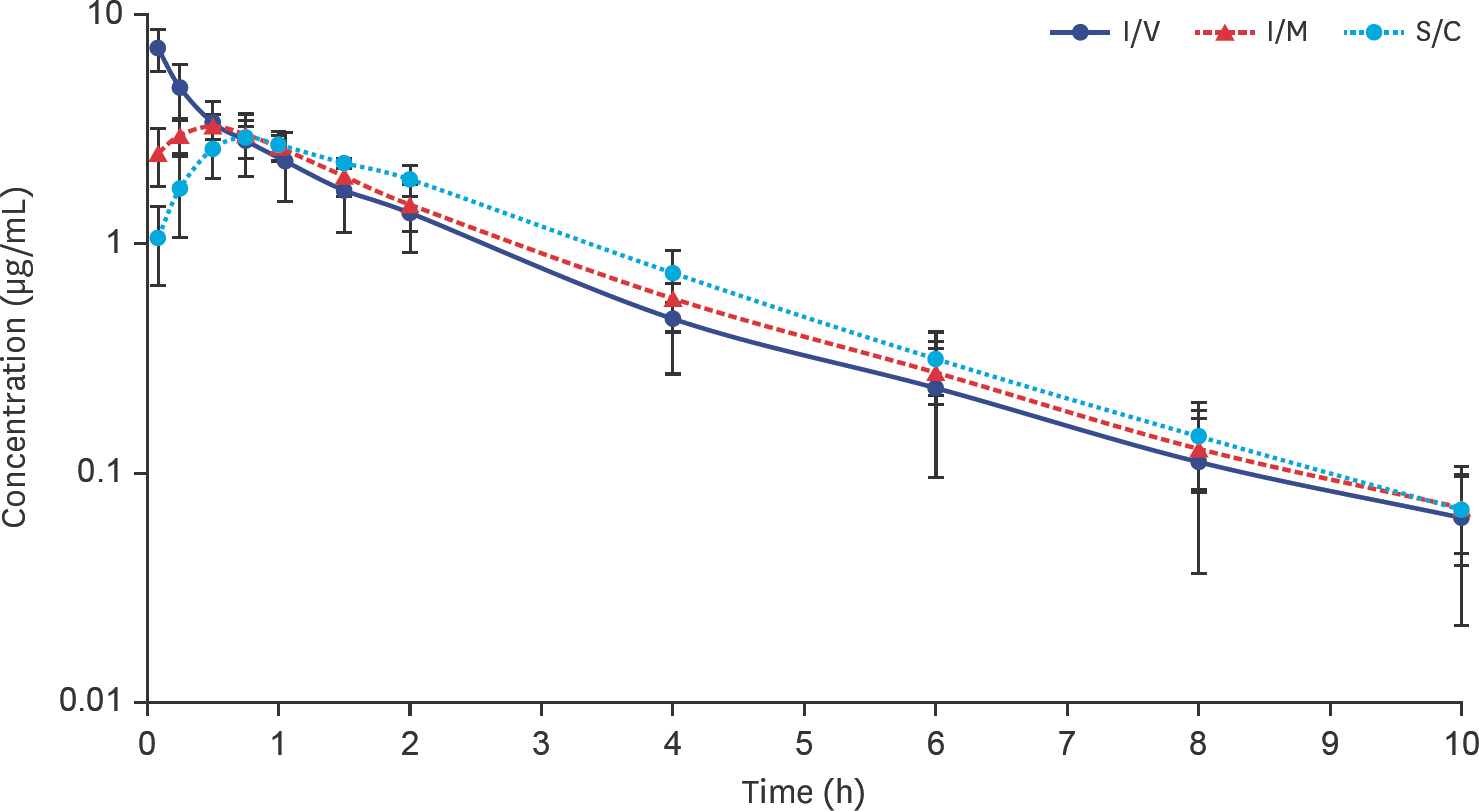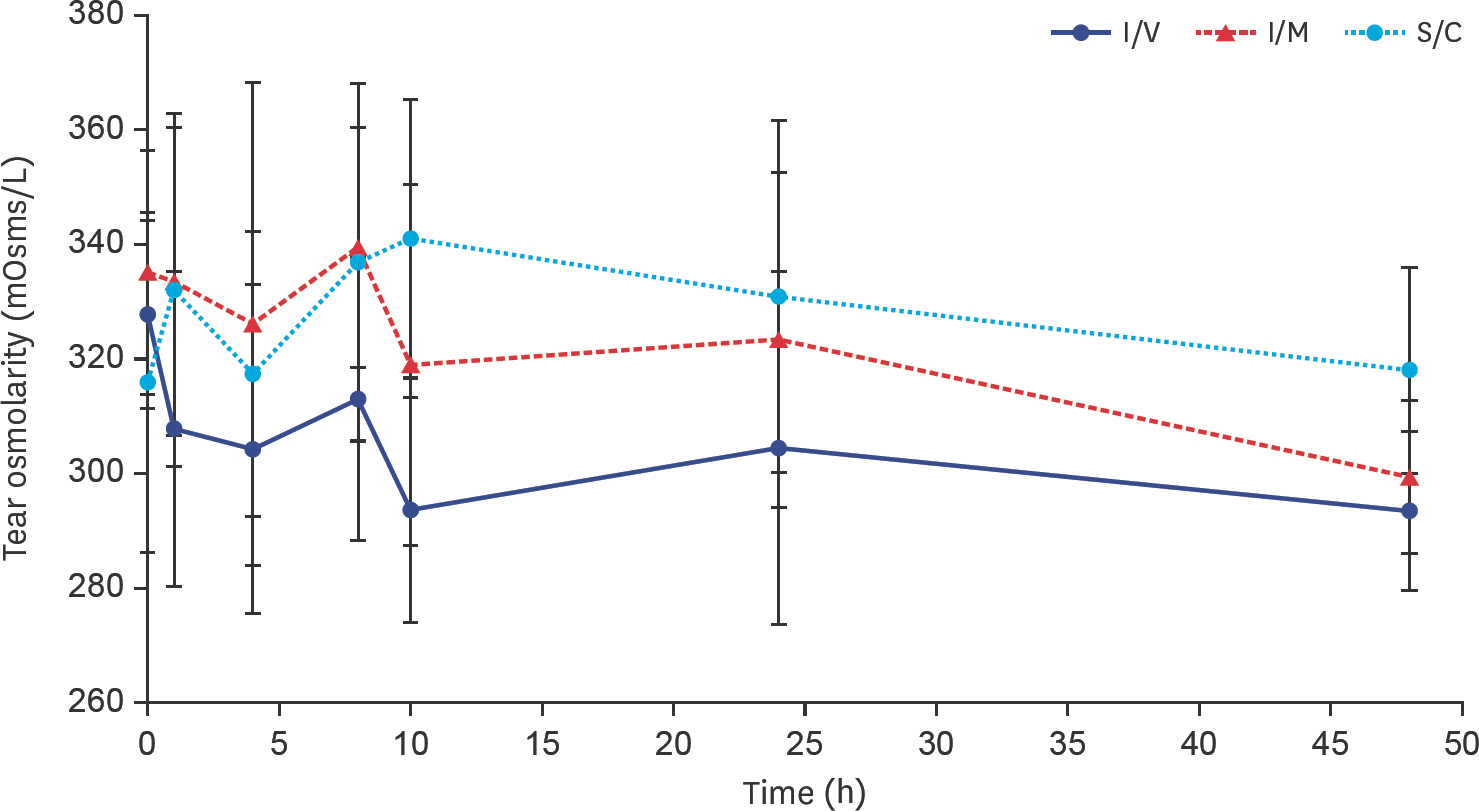J Vet Sci.
2020 Mar;21(2):e32. 10.4142/jvs.2020.21.e32.
Pharmacokinetic profiles of levofloxacin after intravenous, intramuscular and subcutaneous administration to rabbits (Oryctolagus cuniculus)
- Affiliations
-
- 1Department of Pharmacology, Riga Stradins University, Riga, LV-1007, Latvia
- 2Clinical Institute, Faculty of Veterinary Medicine, University of Life Sciences and Technologies, Jelgava, LV-3001, Latvia
- 3Department of Pharmaceutical Chemistry, Riga Stradins University, Riga, LV-1007, Latvia
- 4Department of Veterinary Sciences, University of Pisa, Pisa 56126, Italy
- KMID: 2506177
- DOI: http://doi.org/10.4142/jvs.2020.21.e32
Abstract
- Levofloxacin pharmacokinetic profiles were evaluated in 6 healthy female rabbits after intravenous (I/V), intramuscular (I/M), or subcutaneous (S/C) administration routes at a single dose of 5 mg/kg in a 3 × 3 cross-over study. Plasma levofloxacin concentrations were detected using a validated Ultra Performance Liquid Chromatography method with a fluorescence detector. Levofloxacin was quantifiable up to 10 h post-drug administration. Mean AUC 0-last values of 9.03 ± 2.66, 9.07 ± 1.80, and 9.28 ± 1.56 mg/h*L were obtained via I/V, I/M, and S/C, respectively. Plasma clearance was 0.6 mL/g*h after I/V administration. Peak plasma concentrations using the I/M and S/C routes were 3.33 ± 0.39 and 2.91 ± 0.56 µg/mL. Bioavailability values, after extravascular administration were complete, - 105% ± 27% (I/M) and 118% ± 40% (S/C). Average extraction ratio of levofloxacin after I/V administration was 7%. Additionally, levofloxacin administration effects on tear production and osmolarity were evaluated. Tear osmolarity decreased within 48 h post-drug administration. All 3 levofloxacin administration routes produced similar pharmacokinetic profiles. The studied dose is unlikely to be effective in rabbits; however, it was calculated that a daily dose of 29 mg/kg appears effective for I/V administration for pathogens with MIC < 0.5 µg/mL.
Keyword
Figure
Cited by 1 articles
-
Comparative effects of systemic administration of levofloxacin and cephalexin on fracture healing in rats
Shayan Golestani, Arash Golestaneh, Atousa Aminzadeh Gohari
J Korean Assoc Oral Maxillofac Surg. 2022;48(2):94-100. doi: 10.5125/jkaoms.2022.48.2.94.
Reference
-
References
1. Toutain PL, Ferran A, Bousquet-Melou A. Circulating miR-34a levels are reduced in colorectal cancer. J Surg Oncol 2012;106:947–52.2. Rougier S, Galland D, Boucher S, Boussarie D, Vallé M. Epidemiology and susceptibility of pathogenic bacteria responsible for upper respiratory tract infections in pet rabbits. Vet Microbiol. 2006; 115:192–198.
Article3. Percy DH, Barthold SW. Pathology of Laboratory Rodents and Rabbits. 3rd ed.Ames: Blackwell Publishing;2008.4. Riviere JE, Papich MG. Veterinary Pharmacology and Therapeutics. 10th ed.Ames: John Wiley & Sons;2018.5. Brown SA. Fluoroquinolones in animal health. J Vet Pharmacol Ther. 1996; 19:1–14.
Article6. Martinez M, McDermott P, Walker R. Pharmacology of the fluoroquinolones: a perspective for the use in domestic animals. Vet J. 2006; 172:10–28.
Article7. Landoni MF, Albarellos GA. Pharmacokinetics of levofloxacin after single intravenous, oral and subcutaneous administration to dogs. J Vet Pharmacol Ther. 2019; 42:171–178.
Article8. Davis R, Bryson HM. Levofloxacin. A review of its antibacterial activity, pharmacokinetics and therapeutic efficacy. Drugs. 1994; 47:677–700.9. Giguère S, Prescott JF, Dowling PM. Antimicrobial Therapy in Veterinary Medicine. Ames: John Wiley & Sons;2013.10. Albarellos GA, Ambros LA, Landoni MF. Pharmacokinetics of levofloxacin after single intravenous and repeat oral administration to cats. J Vet Pharmacol Ther. 2005; 28:363–369.
Article11. Madsen M, Messenger K, Papich MG. Pharmacokinetics of levofloxacin following oral administration of a generic levofloxacin tablet and intravenous administration to dogs. Am J Vet Res. 2019; 80:957–962.
Article12. Goudah A. Pharmacokinetics of levofloxacin in male camels (Camelus dromedarius). J Vet Pharmacol Ther. 2009; 32:296–299.13. Goudah A, Abo-El-Sooud K. Pharmacokinetics, urinary excretion and milk penetration of levofloxacin in lactating goats. J Vet Pharmacol Ther. 2009; 32:101–104.
Article14. Goudah A, Hasabelnaby S. Disposition kinetics of levofloxacin in sheep after intravenous and intramuscular administration. Vet Med Int. 2010; 2010:727231.
Article15. Varia RD, Patel JH, Patel UD, Bhavsar SK, Thaker AM. Disposition of levofloxacin following oral administration in broiler chickens. Isr J Vet Med. 2009; 64:118–121.16. Lee HK, DeVito V, Vercelli C, Tramuta C, Nebbia P, Re G, Kovalenko K, Giorgi M. Ex vivo antibacterial activity of levofloxacin against Escherichia coli and its pharmacokinetic profile following intravenous and oral administrations in broilers. Res Vet Sci. 2017; 112:26–33.17. Aboubakr M. Pharmacokinetics of levofloxacin in Japanese quails (Coturnix japonica) following intravenous and oral administration. Br Poult Sci. 2012; 53:784–789.18. Aboubakr M, Soliman A. Comparative pharmacokinetics of levofloxacin in healthy and renal damaged Muscovy ducks following intravenous and oral administration. Vet Med Int. 2014; 2014:986806.
Article19. Toutain PL, del Castillo JR, Bousquet-Mélou A. The pharmacokinetic-pharmacodynamic approach to a rational dosage regimen for antibiotics. Res Vet Sci. 2002; 73:105–114.
Article20. Papich MG. Pharmacokinetic-pharmacodynamic (PK-PD) modeling and the rational selection of dosage regimes for the prudent use of antimicrobial drugs. Vet Microbiol. 2014; 171:480–486.
Article21. Destache CJ, Pakiz CB, Larsen C, Owens H, Dash AK. Cerebrospinal fluid penetration and pharmacokinetics of levofloxacin in an experimental rabbit meningitis model. J Antimicrob Chemother. 2001; 47:611–615.
Article22. Shellim C. Parenteral drug administration. Vet Nurs J. 2011; 26:117–119.
Article23. Krustev SZ, Rusenova NV, Haritova AM. Effect of diclofenac on ocular levels of ciprofloxacin and lomefloxacin in rabbits with endophthalmitis. Drug Dev Ind Pharm. 2014; 40:1459–1462.
Article24. Sakai T, Shinno K, Kurata M, Kawamura A. Pharmacokinetics of azithromycin, levofloxacin, and ofloxacin in rabbit extraocular tissues after ophthalmic administration. Ophthalmol Ther. 2019; 8:511–517.
Article25. Blomquist PH, Palmer BF. Ocular complications of systemic medications. Am J Med Sci. 2011; 342:62–69.
Article26. Shirani D, Selk Ghaffari M, Akbarein H, Haji Ali Asgari A. Effects of short-term oral administration of trimethoprim-sulfamethoxazole on Schirmer II tear test results in clinically normal rabbits. Vet Rec. 2010; 166:623–624.
Article27. Rajaei SM, Ansari Mood M, Selk Ghaffari M, Razaghi Manesh SM. Effects of short-term oral administration of trimethoprim-sulfamethoxazole on tear production in clinically normal Syrian hamsters. Vet Ophthalmol. 2015; 18:83–85.
Article28. Toutain PL, Bousquet-Mélou A. Plasma clearance. J Vet Pharmacol Ther. 2004; 27:415–425.
Article29. Gabrielsson J, Daniel W. Pharmacokinetic and Pharmacodynamic Data Analysis – Concepts and Applications. 5th ed.Stockholm: Swedish Pharmaceutical Press;2016.30. Toutain PL, Bousquet-Mélou A. Plasma terminal half-life. J Vet Pharmacol Ther. 2004; 27:427–439.
Article31. Kumar A, Rahal A, Ragvendra R, Prakash A, Mandil R, Garg SK. Pharmacokinetics of levofloxacin following intravenous and intramuscular administration in cattle calves. Asian J Anim Vet Adv. 2012; 7:1006–1013.
Article32. Basyigit I, Kahraman G, Ilgazli A, Yildiz F, Boyaci H. The effects of levofloxacin on ECG parameters and late potentials. Am J Ther. 2005; 12:407–410.
Article33. Marín P, Fernández-Varón E, Escudero E, Vancraeynest D, Cárceles CM. Pharmacokinetic-pharmacodynamic integration of orbifloxacin in rabbits after intravenous, subcutaneous and intramuscular administration. J Vet Pharmacol Ther. 2008; 31:77–82.34. Fernández-Varón E, Bovaira MJ, Espuny A, Escudero E, Vancraeynest D, Cárceles CM. Pharmacokinetic-pharmacodynamic integration of moxifloxacin in rabbits after intravenous, intramuscular and oral administration. J Vet Pharmacol Ther. 2005; 28:343–348.
Article35. Patel UD, Patel JH, Bhavsar SK, Thaker AM. Pharmacokinetics of levofloxacin following intravenous and subcutaneous administration in sheep. Asian J Anim Vet Adv. 2012; 7:85–93.
Article36. Marín P, García-Martínez F, Hernándis V, Escudero E. Pharmacokinetics of norfloxacin after intravenous, intramuscular and subcutaneous administration to rabbits. J Vet Pharmacol Ther. 2018; 41:137–141.
Article37. Fernández-Varón E, Marin P, Escudero E, Vancraeynest D, Cárceles CM. Pharmacokinetic-pharmacodynamic integration of danofloxacin after intravenous, intramuscular and subcutaneous administration to rabbits. J Vet Pharmacol Ther. 2007; 30:18–24.
Article38. Toutain PL, Bousquet-Mélou A. Bioavailability and its assessment. J Vet Pharmacol Ther. 2004; 27:455–466.
Article39. Abo-el-Sooud K, Goudah A. Influence of Pasteurella multocida infection on the pharmacokinetic behavior of marbofloxacin after intravenous and intramuscular administrations in rabbits. J Vet Pharmacol Ther. 2010; 33:63–68.40. Marangos MN, Zhu Z, Nicolau DP, Klepser ME, Nightingale CH. Disposition of ofloxacin in female New Zealand white rabbits. J Vet Pharmacol Ther. 1997; 20:17–20.
Article41. Mitchell M, Tully TN. Manual of Exotic Pet Practice. St. Louis: Elsevier Health Sciences;2008.42. Harcourt-Brown F. Textbook of Rabbit Medicine. London: Elsevier;2002.43. Rajaei SM, Rafiee SM, Ghaffari MS, Masouleh MN, Jamshidian M. Measurement of tear production in English Angora and Dutch rabbits. J Am Assoc Lab Anim Sci. 2016; 55:221–223.
- Full Text Links
- Actions
-
Cited
- CITED
-
- Close
- Share
- Similar articles
-
- Disposition kinetics and dosage regimen of levofloxacin on concomitant administration with paracetamol in crossbred calves
- Pharmacokinetics, urinary excretion and dosage regimen of levofloxacin following a single intramuscular administration in cross bred calves
- Seroprevalence of Encephalitozoon cuniculi and Toxoplasma gondii in domestic rabbits (Oryctolagus cuniculus) in China
- Clinical Efficacy and Safety of Intravenous levofloxacin in Patients of Abdominal Operati
- Influence of endotoxin induced fever on the pharmacokinetics of intramuscularly administered cefepime in rabbits



